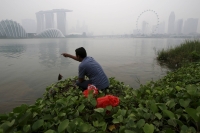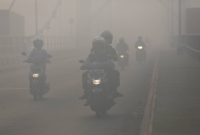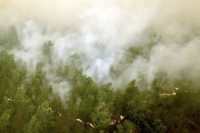Southeast Asian nations are gearing up to tackle the threat of a tougher-than-usual "haze" season together, as El Nino raises the risk of soaring temperatures.
Ministers and officials from the Association of Southeast Asian Nations (ASEAN) met in Singapore last month, where they vowed to ramp up monitoring of wildfires and efforts to prevent air pollution, and finalize a new plan to boost cooperation.
During the dry season in Indonesia — usually starting in August — slash-and-burn clearance of forest and peatland to expand palm oil, farming, and pulp and paper production covers much of Southeast Asia in a choking haze for months most years.
Yet environmentalists are concerned that this haze season could be the worst in years, after the World Meteorological Organization warned that temperatures are expected to surge across large parts of the world following the emergence of El Nino in the tropical Pacific for the first time since 2016.
"The prediction is that we are due for a strong El Nino," said Helena Varkkey, an associate professor of environmental politics and governance at the University of Malaya in Kuala Lumpur. "Fires, once they occur, will likely be sustained over long periods and move across national boundaries."
After a few haze-free years — due to the COVID-19 pandemic and wet weather — a new regional roadmap to address the issue will prove vital ahead of the upcoming season, Varkkey said.
"It's important to focus on data standardization, sharing and use — (of) air quality indexes, hotspot data — to support cross-border coordination," she added.
With the prospect of prolonged hot and dry weather raising the risk of widespread haze and air pollution if the burning of forests and peatland is uncontrolled, ASEAN is seeking to avoid a repeat of recent haze crises like those in 2019 and 2015.
In 2015, between June and October, about 2.6 million hectares (6.4 million acres) of land burned in Indonesia, mainly on Sumatra and Borneo islands, according to a 2016 World Bank report. The fires cost the country about $16 billion, it found.
A Harvard University study linked the 2015 haze to more than 100,000 premature deaths in Indonesia, Malaysia and Singapore.
During previous haze seasons, Southeast Asian nations often failed to work together, experts said, with governments publicly blaming each other and taking little cross-border action, while any ASEAN policies were seen as too weak to make a real impact.
Mushtaq Memon, coordinator of chemicals and pollution action for Asia-Pacific at the United Nations Environment Program (UNEP), said the ASEAN haze-free roadmap will likely be adopted in August and set out a strategy for the rest of the decade.
It will improve implementation and science-based targets, beef up local action and empower communities, and include a new subregional strategy, he said, without giving further details.
"Strengthening institutions and coordination with ASEAN member states and other institutions is a must," Memon said.
"At the national level, monitoring the onset of forest fires, open burning or peatland fires is critical, as well as ensuring immediate, on-the-ground actions to prevent spreading of these fires," he added.
When Indonesia faced regional pressure during the 2015 haze crisis, its focus changed from containing fires to prevention.
After visiting some of the areas worst-hit by forest fires, Indonesian President Joko Widodo introduced a raft of measures that forestry experts say have helped cut the number of blazes.
These include a temporary ban on new palm oil plantations, making permanent a moratorium on new conversion permits for primary forest and peatlands, setting up a Peatland Restoration Agency, and a promise to return more land to Indigenous peoples.
Indonesia's environment and forestry ministry has implemented a comprehensive approach since 2015 that includes early warning systems and peatland restoration, according to Mirey Atallah, head of UNEP's nature-for-climate branch.
The main focus has been on building up the capacities of groups working on fire protection — be they government, private sector, NGOs or local communities, Atallah said.
Indonesia's policies also have an emphasis on the restoration of peatlands — valuable ecosystems that serve as a critical line of defense against fires, she added.
Ancient peaty soil is particularly flammable when dry, often causing fires to spread beyond their intended areas.
"By re-wetting and rehabilitating degraded peatlands ... (Indonesia) aims to restore their natural functions and reduce the vulnerability to fire outbreaks," Atallah said.
Peatland restoration also helps preserve biodiversity and minimize greenhouse gas emissions, she added.
However, green groups say Indonesia lacks transparency when it comes to forest management and tackling fires.
Alex Helan, a researcher at the Rainforest Action Network, a U.S.-based nonprofit, said plantation firms generally want drier conditions as wet peatland is bad for productivity, so they have an incentive to create drier, fire-prone environments.
"New areas of peatlands are still being opened up so the situation could get much worse," said Helan.
"A clear prohibition on new development on peatlands would be an important step forward."
Support from the government, companies and green groups for local communities in fire prevention and monitoring efforts has also been central to reducing fires, said Abdul Halik, a conservation strategist for Asia-Pacific at the Rainforest Trust, a U.S.-based nonprofit.
These groups need to continue to act together in mitigating the haze risk this year, said Halik, adding that investing in more early warning systems would be beneficial.
At a national level, Southeast Asian governments are already taking steps to mitigate the haze risks.
Singapore is stockpiling face masks, readying air-conditioned public spaces — especially for the vulnerable and elderly — and ensuring schools and nursing homes have air purifiers and enough medical supplies.
Malaysia is considering making it mandatory for domestic plantation companies with operations in Indonesia to report on how they are working on forest fire prevention.
Meanwhile, senior Indonesian government officials have told local media that improvements in water reserves and cloud-seeding to trigger rain will reduce the risks of forest fires.
Annisa Rahmawati, a board member at Indonesian conservation group Satya Bumi, said there is still much to do — and stressed that it is not only the responsibility of the government.
"All the people should support the efforts of peatlands and forest protection," she said.
Like other conservationists, Rahmawati called for greater collaboration and trust within ASEAN and a strengthening of domestic laws across the region to create a real deterrent.
While law enforcement and prosecution over forest fires has improved in Indonesia, the process still lacks transparency and often companies have failed to pay fines, she said.
"There is no haze without fire ... (but) it shouldn't only be about fire and putting out fires — we need to address the root of the problem," Rahmawati added.

























With your current subscription plan you can comment on stories. However, before writing your first comment, please create a display name in the Profile section of your subscriber account page.